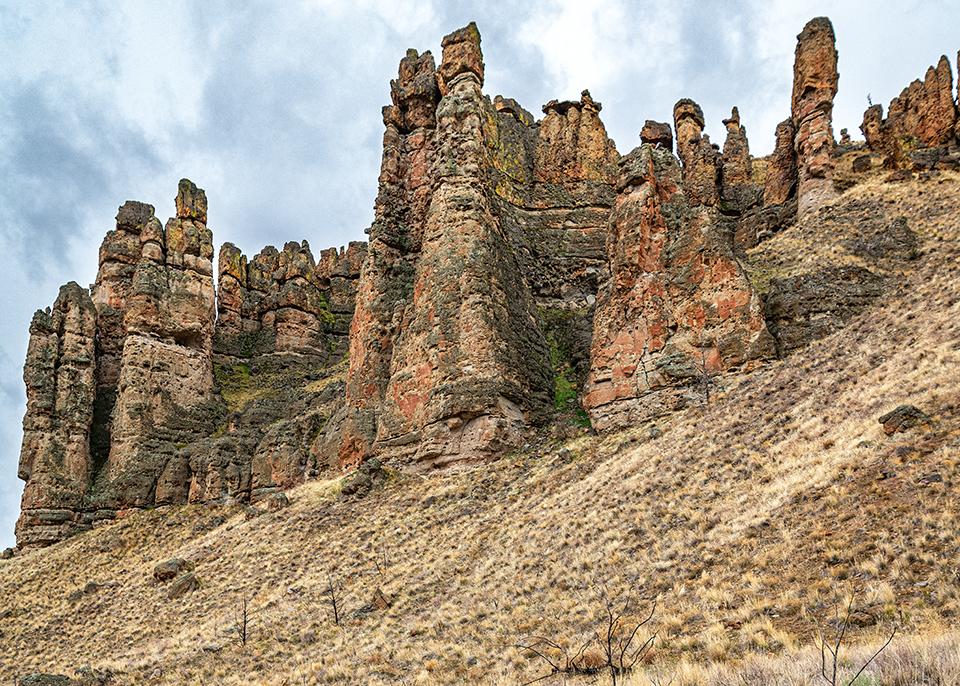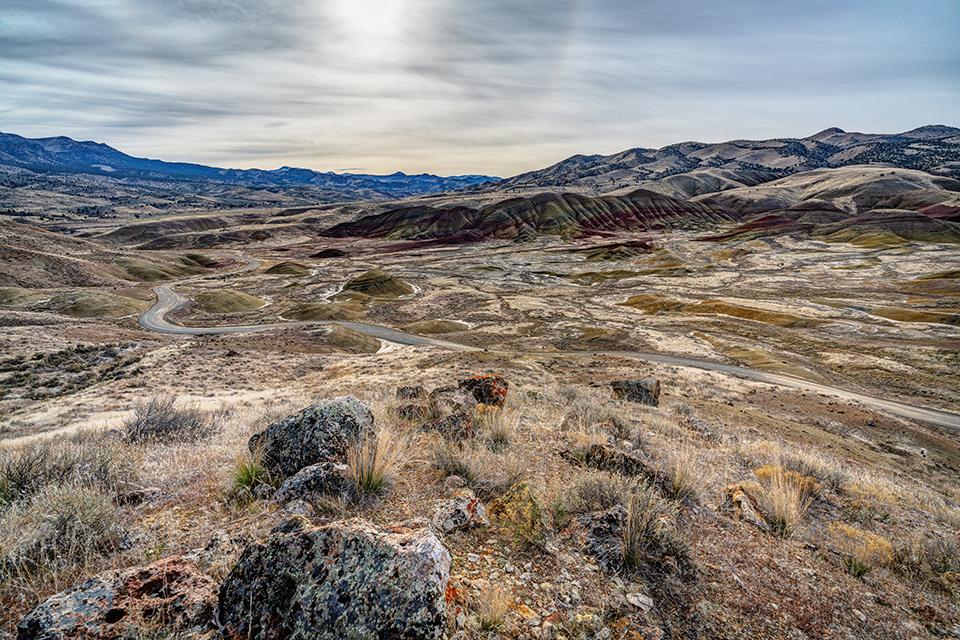
Late afternoon storm clouds and sunlight over the Painted Hills Unit, John Day Fossil Beds National Monument / Rebecca Latson
A trip through east-central Oregon offers a visual feast of colorful, stunning landscapes crafted from the state’s geologic past. If you have a couple of days to spend, then use that time to visit the three different units of John Day Fossil Beds National Monument, where are preserved “a world class record of plant and animal evolution, changing climate, and past ecosystems that span over 40 million years.” This Traveler’s Checklist can help you make the most of your time exploring these units.

Area map of the units in John Day Fossil Beds National Monument / National Park Service
- Each of the park’s units are spaced about an hour’s drive apart. While you can ostensibly see all three in a single day, adding an extra day or two to your explorations allows you to get a feel for each units’ differences. The roads are narrow and winding, with free ranging cattle, so drive the posted speed limit and slow down around those blind curves.
- Services are limited and your best bet for consistent lodging choices, as well as gasoline, will either be in Prineville or John Day. Camping is not allowed in any of the three units of this park, but there are a variety of nearby campgrounds.

The Palisades of the Clarno Unit, John Day Fossil Beds National Monument / Rebecca Latson
- Pack a picnic lunch, take plenty of water, bring sunblock, and start your day with a visit to the Clarno Unit, where the Palisades - volcanic lahars (mudflows) that formed some 54 million years ago - may remind you of castle towers and bastions. Spend the morning hiking the three very short trails ranging from ¼- to ½- mile roundtrip. There are picnic tables and restroom facilities but no water available.
- After your morning visit to the Clarno Unit, head on down the road to the most popular unit of this park: the Painted Hills Unit. The roads throughout this unit are gravel, and RVs are not recommended past the Painted Hills Overlook. There is no visitor center at the Painted Hills Unit, but there is a small kiosk with maps and other information near the entrance of the unit, along with the only restrooms and picnic tables in the unit. There is no available water.
- Make certain you have a camera handy, because the afternoon light is best for photographing the yellow, gold, dark red/maroon, and black colorations of these painted hills. The aptly-named Painted Hills Overlook is one of the best spots for capturing those images.
- There are five short trails within the Painted Hills Unit varying in length from .25 – 1.6 miles roundtrip. If you don’t feel like tackling all of the trails, then do, at least, hike the Carroll Rim Trail for a panoramic, almost 360-degree overview of this unit.
- Stay up past dark to gaze at and maybe photograph the stars and Milky Way over those painted hills.

The view along the Flood of Fire Trail in the Foree Area of the Sheep Rock Unit, John Day Fossil Beds National Monument / Rebecca Latson
- Pack another picnic lunch and bring plenty of water with you for your drive to the Sheep Rock Unit, stopping to gaze at the layers of columnar basalts comprising the Picture Gorge Basalts before spending time visiting the Thomas Condon Paleontology and Visitor Center. There, you can view over 500 fossil specimens discovered in this national monument, watch an 18-minute park orientation film, browse the bookstore, and view through a large picture window into the laboratory to watch scientists clean and study the fossils.
- Hike some or most of the trails within this unit for views of the landscape and close looks at the blue-green claystone formations containing fossils 25-30 million years old.
- Take in a little history about Scottish immigrants James and Elizabeth Cant and their family while exploring the James Cant Ranch Historic District and Museum. Hike the trails that start from the ranch.
- Finish up your exploration of this national monument by driving a little less than 8 miles from the Sheep Rock Unit to the Mascall Overlook, off of U.S. Route 26, for “sweeping views of the John Day Valley and Picture Gorge,” as well as a look at the massive, fossil-bearing Mascall Formation.
- Remember to check the park’s website to find out if and where pets are allowed as well as for any alerts and closures due to construction, weather-related damage, or Covid-19 precautions.
- As you make your trip plans, remember, the coronavirus pandemic is not over, yet. Per the National Park Service, whose parent organization is the Department of the Interior: “To protect the health of those who live, work, and visit America’s national parks, face masks are required in all NPS buildings and facilities. Masks are also required on NPS-managed lands when physical distancing cannot be maintained, including narrow or busy trails, overlooks, and historic homes.” So, travel safely, take some masks, practice social distancing and wash your hands often.

A view of the Painted Hills Unit from the Carroll Rim Trail, John Day Fossil Beds National Monument / Rebecca Latson


 Support Essential Coverage of Essential Places
Support Essential Coverage of Essential Places






